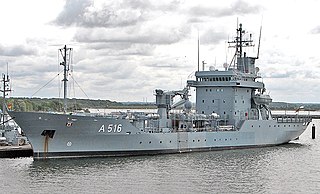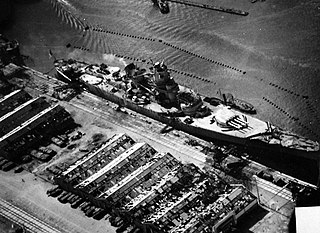Background
As the Industrial Revolution progressed, steam-powered steel ships replaced sail-powered wooden ships; but naval artillery remained the preferred weapon. The first large warship to be sunk by a torpedo was the Chilean ironclad Blanco Encalada in 1891. As major naval powers realized the vulnerability of their expensive battleships to inexpensive torpedo boats, they started building defensive flotillas of torpedo boat destroyers or destroyers for short. [1]
The earliest torpedo boat destroyers were small, to maximize maneuverability, and powered by large steam engines, to maximize speed to intercept enemy torpedo boats before they could get close to the battleships. [1] These torpedo boat destroyers were so full of machinery, coal, quick-firing guns and ammunition that there was not enough room for living quarters for their crew. Destroyer tenders with berthing and dining accommodations for the destroyer crews joined the fleet train of colliers accompanying the battle fleet. The destroyer tenders also carried cooks, administrative and medical personnel, and senior ratings qualified to repair the destroyer machinery. Although individual destroyers were too small for these specialized personnel, the skills of those aboard the tender were available to the whole destroyer flotilla. The tender also carried a supply of spare parts for destroyer machinery. [2]
Evolution
When the Great White Fleet circled the globe in 1907, it was accompanied by a tender, USS Yankton, and a repair ship, USS Panther. [2] Repair ships did not offer the personnel services of a tender, but offered a broader range of repair capability, including equipment and personnel for repair of more significant machinery failures or battle damage. [3] Repair ships carried a fully equipped machine shop and foundry capable of completing any repair not requiring a drydock. [4]
Destroyer displacement had increased to 1,000 tons by World War I and to 2,000 tons for destroyers accompanying the Fast Carrier Task Forces of World War II. [5] United States destroyer tenders of World War II carried some destroyer ammunition and depth charges, and performed torpedo maintenance and resupply, but focused on repair work. The Dixie class had a foundry, forge, metal lathes, and welders for heavy repairs, plus an optical shop and clockmakers to repair binoculars, sextants, marine chronometers, optical rangefinders, and fire-control system computers. These tenders operated stills and electric generators to supply fresh water and electrical power to destroyers moored alongside for boiler repair. [6]
Each increment of size enabled destroyers to carry more of the personnel and equipment previously found on the tender. Destroyers reached the size of cruisers during the Cold War, and with that size acquired a cruiser's capability for independent action. Surviving tenders became functionally indistinguishable from repair ships. [7]
Some destroyer tenders were designed and built to attend a flotilla of destroyers, while others were converted from ships built for other purposes. Tabled below is a comparison of ships designed as destroyer tenders:
| Name | Date | Number | Nation | Displacement | Speed | Crew |
|---|
| USS Melville [8] | 1915 | 1 | US | 5,250 tons | 15 knots | 600 |
| HMS Greenwich [9] | 1915 | 1 | UK | 8,100 tons | 11 knots | 224 |
| Altair class | 1918 | 3 | US | 6.250 tons | 10.5 knots | 481 |
| Dobbin class [8] | 1921 | 2 | US | 8,325 tons | 16 knots | 600 |
| Dixie class [8] | 1939 | 5 | US | 9,450 tons | 19 knots | 1,262 |
| Hamul class | 1940 | 2 | US | 8,560 tons | 17 knots | 857 |
| Hecla class [10] | 1940 | 2 | UK | 10,850 tons | 17 knots | 818 |
| Klondike class [8] | 1944 | 4 | US | 8,560 tons | 18 knots | 860 |
| Shenandoah class | 1944 | 6 | US | 11,755 tons | 18 knots | 1,035 |
| Samuel Gompers class [11] | 1966 | 2 | US | 21,000 tons | 18 knots | 1,803 |
| Yellowstone class [7] | 1979 | 4 | US | 20,224 tons | 18 knots | 1,595 |
|

A ship's tender, usually referred to as a tender, is a boat or ship used to service or support other boats or ships. This is generally done by transporting people or supplies to and from shore or another ship.

High-speed transports were converted destroyers and destroyer escorts used in US Navy amphibious operations in World War II and afterward. They received the US Hull classification symbol APD; "AP" for transport and "D" for destroyer. In 1969, the remaining ships were reclassified as "Fast Amphibious Transports", hull symbol LPR.

Destroyer escort (DE) was the United States Navy mid-20th-century classification for a 20-knot warship designed with the endurance necessary to escort mid-ocean convoys of merchant marine ships.

A fleet submarine is a submarine with the speed, range, and endurance to operate as part of a navy's battle fleet. Examples of fleet submarines are the British First World War era K class and the American World War II era Gato class.

USS Abel P. Upshur (DD-193) was a Clemson-class destroyer in the service of the United States Navy and United States Coast Guard until transferred to the United Kingdom in 1940. During World War II, she served in the Royal Navy as HMS Clare.

The Town-class destroyers were a group of 50 destroyers of the Royal Navy and the Royal Canadian Navy that were in service during the Second World War. They were transferred from the United States Navy in exchange for military bases in the British West Indies and Newfoundland, as outlined in the Destroyers for Bases Agreement between the United Kingdom and United States, signed on 2 September 1940. They were known as "four-pipers" or "four-stackers" because they had four smokestacks (funnels). Later classes of destroyers typically had one or two.

HMS Ambuscade was a British Royal Navy destroyer which served in the Second World War. She and her Thornycroft competitor, HMS Amazon, were prototypes designed to exploit advances in construction and machinery since World War I and formed the basis of Royal Navy destroyer evolution up to the Tribal of 1936.

Destroyer leader (DL) was the United States Navy designation for large destroyers from 9 February 1951 through the early years of the Cold War. United States ships with hull classification symbol DL were officially frigates from 1 January 1955 until 1975. The smaller destroyer leaders were reclassified as destroyers and the larger as cruisers by the United States Navy 1975 ship reclassification so destroyer escorts could be reclassified as frigates (FF) in conformance with international usage of the term.

The 3-inch/50-caliber gun in United States naval gun terminology indicates the gun fired a projectile 3 inches (76 mm) in diameter, and the barrel was 50 calibers long. Different guns of this caliber were used by the U.S. Navy and U.S. Coast Guard from 1900 through to 1990 on a variety of combatant and transport ship classes.

A depot ship is an auxiliary ship used as a mobile or fixed base for submarines, destroyers, minesweepers, fast attack craft, landing craft, or other small ships with similarly limited space for maintenance equipment and crew dining, berthing and relaxation. Depot ships may be identified as tenders in American English. Depot ships may be specifically designed for their purpose or be converted from another purpose.

HMS Matabele was a Tribal-class destroyer of the Royal Navy that saw service in World War II, being sunk by a U-boat on 17 January 1942. She has been the only ship of the Royal Navy to bear the name Matabele, which in common with the other ships of the Tribal class, was named after an ethnic group of the British Empire. In this case, this was the Anglicisation of the Ndebele people of Zimbabwe.

HMS Cossack was a Tribal-class destroyer of the Royal Navy launched in 1907 and sold in 1919.

HMS Zephyr was one of two Fervent-class destroyers which served with the Royal Navy. She was launched on 10 May 1895 from Hanna, Donald & Wilson at Paisley, Scotland. She served in home waters, and was sold in 1920.

The Naval Battle of Casablanca was a series of naval engagements fought between American ships covering the invasion of North Africa and Vichy French ships defending the neutrality of French Morocco in accordance with the Second Armistice at Compiègne during World War II.

A repair ship is a naval auxiliary ship designed to provide maintenance support to warships. Repair ships provide similar services to destroyer, submarine and seaplane tenders or depot ships, but may offer a broader range of repair capability including equipment and personnel for repair of more significant machinery failures or battle damage.

Z32 was a German Type 1936A (Mob) destroyer, which was completed in 1942 and which served with the 8th Destroyer Flotilla of the Kriegsmarine during the Second World War. She fought in the Battle of the Bay of Biscay against HMS Glasgow and HMS Enterprise, alongside the German 8th Destroyer Flotilla and the 4th Torpedo Boat Flotilla. She mainly operated from German-occupied French Atlantic ports, escorting blockade runners and U-boats, and was sunk during the Battle of Ushant on 9 June 1944.
HMS Talybont was a Type III Hunt-class escort destroyer which served in the Royal Navy. She was launched in February 1943 and completed in May that year, serving for the rest of the Second World War. She took part in the Normandy Landings in June 1944, supporting the landings at Omaha Beach and the Pointe du Hoc. Post war she served in the Mediterranean before being reduced to reserve at the end of 1947. She was sold for scrap in 1961, with disposal completed by 1962.

The TB 114 class was a class of four 160-foot torpedo boats built for the British Royal Navy in 1903–1905 by the shipbuilder J. Samuel White. All four ships served in local defence flotillas during the First World War, with one of the ships being sunk in 1918. The remaining three ships were withdrawn from use after the end of the war, with the last of the class sold for scrap in 1921.
HMS Spenser was a Thornycroft type flotilla leader of the British Royal Navy. She was built by J I Thornycroft from 1916 to 1917 as the lead ship of her class, launching in September 1917 and completing in December that year.

HMS Moresby was a Admiralty M-class destroyer which served with the Royal Navy during the First World War. The M class were an improvement on the previous L-class, capable of higher speed. Originally laid down as HMS Marlion by J. Samuel White at East Cowes on the Isle of Wight, the vessel was renamed before being launched on 20 November 1915. At the Battle of Jutland, the destroyer was initially cover for the seaplane tender Engadine but soon joined the action as part of a flotilla led by the light cruiser Champion. Moresby attacked the German fleet with torpedoes, initially unsuccessfully targeting the dreadnought battleship Markgraf and, near the end of the battle, unleashing another which narrowly missed the battlecruiser Von der Tann. In March 1918, the destroyer sank U-110 with the destroyer Michael. After the war, the destroyer was placed in reserve and eventually sold to be broken up on 9 May 1921.


















